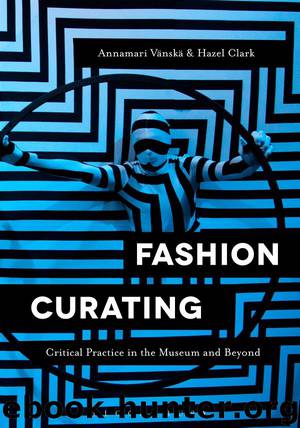Fashion Curating: Critical Practice in the Museum and Beyond by Annamari Vänskä & Hazel Clark

Author:Annamari Vänskä & Hazel Clark
Language: eng
Format: epub
ISBN: 9781474287128
Publisher: Bloomsbury Publishing
Published: 2017-09-07T00:00:00+00:00
Figure 7.3 Timo Wright, still-image from the video accompanying the dance piece “un-fit,” 2012. © Timo Wright.
The installation “Cultural Dresscode” also investigated ways in which people differentiate themselves from others and construct their identities through clothing. Originally, this piece was based on ethnographic interviews in six socio-economically different locations in Helsinki. The artists set up an interview booth in a public space, and invited passers-by to fill in a questionnaire about their relationship to clothing and what they wanted to communicate through it. They also photographed each interviewee and eventually created “an ideal outfit” that represented the typology of each socio-economic group in each location. The results of the interviews, photographs of interviewees and the ideal outfits of each location were installed in a fitting room in the exhibition. Later on, when “Cultural Dresscode” was displayed in New York, Tokyo and Berlin, it was modified in many ways to fit in each specific location. First, the name was shortened to “Dresscode” which already includes the idea that conventions and norms regarding dress and dressing up are always culturally constructed, not natural facts. In New York the project was realized in the same spirit as in Helsinki, but in three different locations area: the Bronx, Manhattan and Brooklyn. The results from each location were represented in fitting rooms under the title of each borough. However, when the exhibition travelled to Tokyo, there was no funding to realize the research project. An alternative way of representing the piece had to be imagined. In collaboration with the artists we decided to exhibit the previous cities as results of visual research on screens installed in fitting rooms with the name of the respective city “Helsinki” and “New York.” What is more, the current exhibiting location, “Tokyo,” became a platform of an ongoing research process. This was realized by setting up a photo studio in the exhibition space and asking visitors to take a photograph of themselves which were streamed to a screen in the “Tokyo” fitting room (see Figure 7.4). The same method was utilized in Berlin—this time the ongoing process was realized by asking visitors to take a selfie and to send it online to a certain address where the images were collected to be shown on-screen in a fitting room entitled “Berlin.” Currently the installation consists of hundreds of photographs of street styles in Helsinki, New York, Tokyo and Berlin. It has become a valuable form of documentation and a large corpus of visual material for future research of fashion. It exemplifies how fashion curating need not only be about displaying haute couture, but also about everyday fashions. It is also an example of how interdisciplinary collaboration and socially engaging projects can produce results that are widely accessible and underline the democratic appeal of fashion.
Download
This site does not store any files on its server. We only index and link to content provided by other sites. Please contact the content providers to delete copyright contents if any and email us, we'll remove relevant links or contents immediately.
| Anthropology | Archaeology |
| Philosophy | Politics & Government |
| Social Sciences | Sociology |
| Women's Studies |
Cecilia; Or, Memoirs of an Heiress — Volume 1 by Fanny Burney(32433)
Cecilia; Or, Memoirs of an Heiress — Volume 2 by Fanny Burney(31866)
Cecilia; Or, Memoirs of an Heiress — Volume 3 by Fanny Burney(31850)
The Great Music City by Andrea Baker(31319)
We're Going to Need More Wine by Gabrielle Union(18967)
All the Missing Girls by Megan Miranda(15560)
Pimp by Iceberg Slim(14376)
Bombshells: Glamour Girls of a Lifetime by Sullivan Steve(13971)
Talking to Strangers by Malcolm Gladwell(13218)
Norse Mythology by Gaiman Neil(13204)
Fifty Shades Freed by E L James(13157)
For the Love of Europe by Rick Steves(12912)
Mindhunter: Inside the FBI's Elite Serial Crime Unit by John E. Douglas & Mark Olshaker(9186)
Crazy Rich Asians by Kevin Kwan(9164)
The Lost Art of Listening by Michael P. Nichols(7403)
Enlightenment Now: The Case for Reason, Science, Humanism, and Progress by Steven Pinker(7227)
The Four Agreements by Don Miguel Ruiz(6618)
Bad Blood by John Carreyrou(6543)
Weapons of Math Destruction by Cathy O'Neil(6139)
